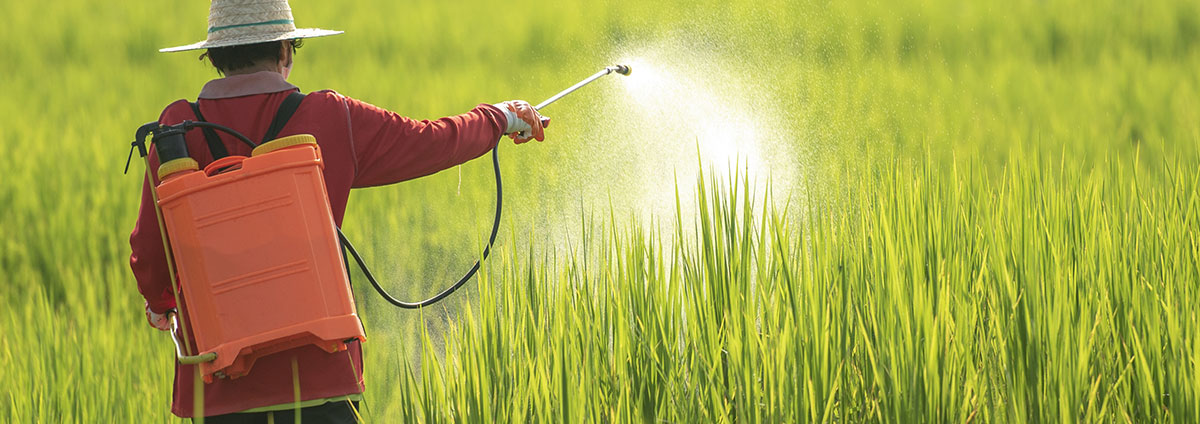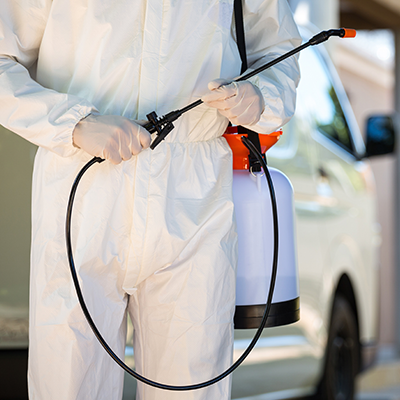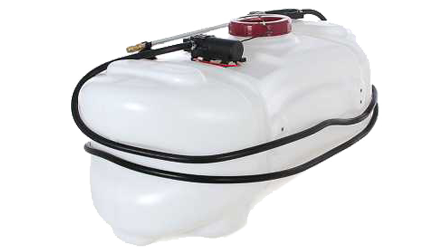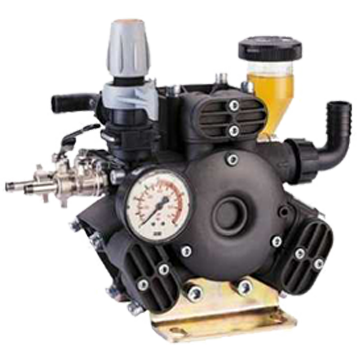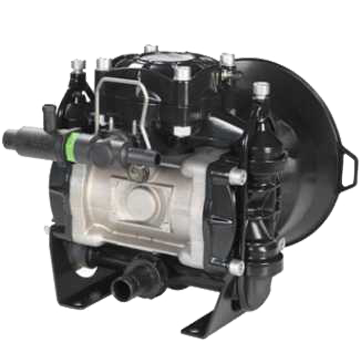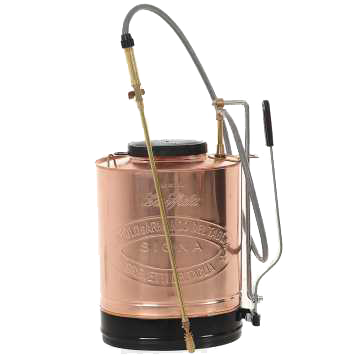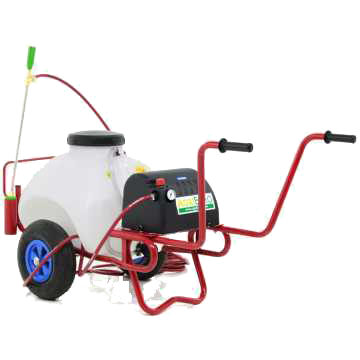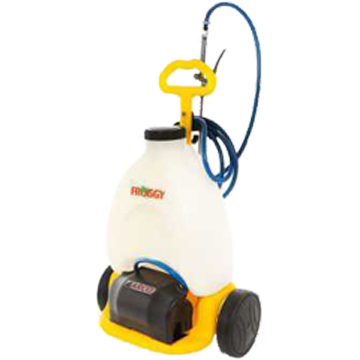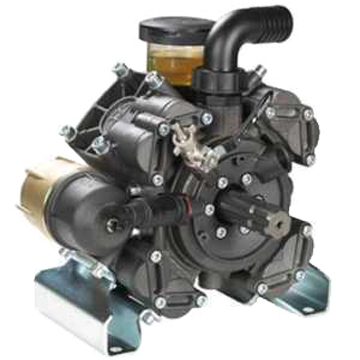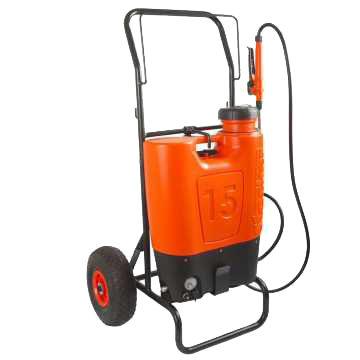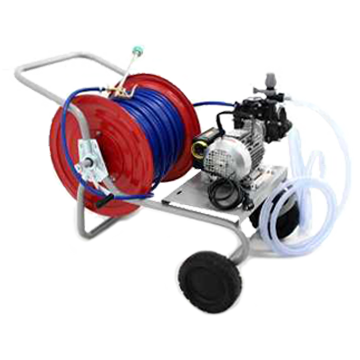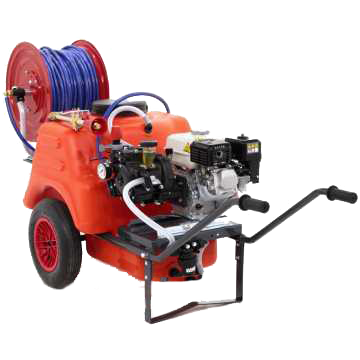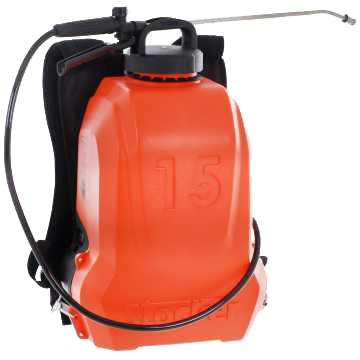A comprehensive guide to purchasing the best sprayer pump, with lots of useful information and explanations on weed control and its functions.
The Complete Guide to help you choose the Best Sprayer Pump
by the Real Experts of Machinery for Spraying Treatments and Weeding
The sprayer pump is an essential tool for all those who own a garden or a vegetable patch, large or small, with flowers, trees or fruit plants. Garden owners are aware of how much these tools are essential to carry out treatments on plants periodically, by spraying liquids to protect them from any kind of parasite or insect that can compromise the productivity and – in the worst case – the health for the plant.
These are the normal treatments usually carried out on plants and trees, also required in the so-called “biological” cultivation, at a professional or hobby level, and which are necessary for healthy plant growth.
Often, and especially among less experienced users, there can be some confusion when purchasing these tools. This is because there are several types of spraying pumps available on the market, with various power supplies and each designed for a different direction for use.
This purchasing guide has been created to help you choose the best sprayer pump for your needs by explaining some of the key aspects in a clear and simple way.

CONTENTS
1. What is a “sprayer pump”?
Sprayer pumps are machines designed for the application of herbicides and to carry out spraying treatments to plants, flowers and various types of crops.
Generally, the terms “spraying pumps “,”sprayers ” or “spray pumps“, refer to any agricultural machine which is:
- able to spray herbicide, chemical or biological;
- equipped with a tank (or barrel), and features a spray lance and a pump fed manually (such as in some more traditional knapsack spraying pump models), or battery-operated, electric, 2/4-stroke or towed by a tractor.
2. Structure
A normal sprayer pump must necessarily have 4 fundamental elements, namely the pump, the tank, the hose and a lance.
2.1 The tank
The tank is one of the essential components of sprayer pumps. It contains the liquid to be sprayed, which can be a weed killer, a fertiliser, a pesticide or even an insecticide.
They are made of plastic materials, such as polyethylene, polyester or PVC, or in fiberglass, to ensure greater strength and easier repair in the event of damage. In some particular cases, for example when more aggressive chemicals need to sprayed, tanks made of stainless steel are used, which are more resistant, reliable and long-lasting than other materials used.
They are available in a variety of sizes and capacities, usually starting at 5 litres for smaller models and with limited capacity, such as portable or backpack models, and going up to 2000 – 6000 litres in heavy-duty models to be combined with more powerful engine-driven pumps and self-propelled machines.
As for tractor-driven models, there are tanks with a capacity ranging from 300 to 1000 litres, while in wheelbarrow or towed models, tanks range from 600 to 3000 litres.
2.2 The lance
The lances are the part held by the user to direct the jet towards the plants and nebulise the product contained in the tank.
According to the level of use of the product, there are different types of lances:
- Plastic lances
Equipped with adjustable and interchangeable nozzles and are very common in low-cost, non-professional models; - Plastic and metal spears
Given the materials used, this type of lance has greater resistance than plastic models. Usually the tube and the terminal are made of aluminum, while the handle is made of plastic; - Brass lances
They are much more popular among high-end heavy-duty models due to their resistance and performance.
Another aspect that should not be underestimated concerns the nozzles, which have a major role in terms of spraying uniformity, as well as coverage and capacity of the machine. The function of these small components is that of pulverise the liquid contained in the tank through the pressure exerted.
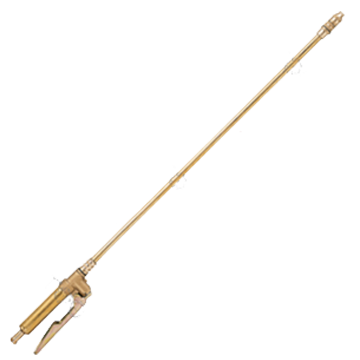
Heavy-duty lance in brass 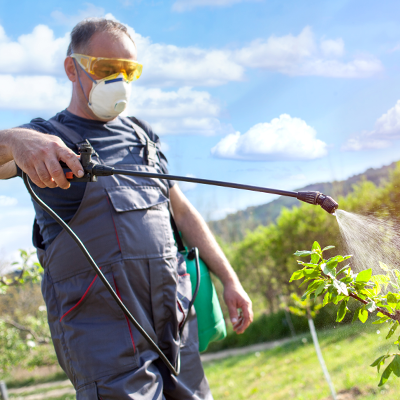
Plastic lance 
Brass and plastic lance
In order for the machine to work at its best, the equipment must be kept clean, including the nozzles, which should always be disassembled and cleaned after use to prevent them from clogging and compromising the effectiveness of the machine.
This is why it is very important to consider buying machines with detachable nozzles, both to be able to intervene easily in the event of a blockage, and, more simply, to be able to replace them with more suitable ones according to the use to be made.
This normal precaution will guarantee a regular spraying of the liquid, improving the life of the machine and the operation itself.

Pair of spray guns with brass nozzles, professional ceramic nozzle and plastic diffusor 
Brass nozzles set
2.3 The pump
One of the main components of a sprayer is the pump, which performs the essential function of pressurising the liquid to be sprayed and can be driven either by a hydraulic system or by a power take-off.
Most sprayer pumps are equipped with a piston, diaphragm or rotary vane pump.
- Diaphragm sprayer pumps are a kind of piston pump that has a membrane inside, which performs a pumping function that is essential for its operation. These pumps use alternating expansions and contractions of the volume of a chamber to increase the pressure and produce the actual pumping of the liquid stored inside the tank.
Diaphragm sprayer pumps consist of two basic parts: the transmission, which transfers the mechanical energy from the motor to the pump, and the pumping unit, which converts the mechanical energy released by the motor into the dynamic pressure of the pumped liquid.
The flow rate of these pumps can be as high as 50 bar. - Piston pumps alternately compress and expand the volume of the pumping chamber by means of a piston moving along an axis inside the cylinder, causing the pressurised liquid to flow out.
These pumps can reach pressures of up to 80 bar. - Rotary vane pumps are driven by rotating elements which, by moving around their own axis, act on the piston and allow the liquid to escape under pressure.
A sprayer pump can have different power supplies. In fact, they can be:
- Manually-operated (by acting with one hand on a lever usually located on the side of the tank)
- Battery-operated
- powered by a 2/4-stroke engine
- powered by an electric motor
- driven by a tractor’s PTO
3. Relevant parameters
Before proceeding with the purchase of a sprayer, it is very important to bear in mind a number of parameters to determine whether the machine suits your requirements.
- Pressure:
among the most important features for a sprayer pump is the pressure, i.e. the force with which the machine feeds the pumped liquid; in other words, the force with which the fluid comes out.
The higher the pressure, the greater the spraying power.
It is clear that a sprayer with a good pressure, combined with a good telescopic pole, will be able to distribute the product to the highest points of the plant with very little effort and without using a ladder. This is why it is very important to take this parameter into consideration. - Flow rate:
it corresponds to the volume pumped, i.e. the volume of liquid delivered by the pump in a given time interval, which is usually indicated in litres per minute (L/min.), gallons per minute (gpm) or cubic metres per second (m³/s). - Head lift:
it is the ability of a pump to lift a given volume of liquid at a given height above a certain level, that is, the maximum lifting height.
It is closely linked to the flow rate, since as the latter increases, the head lift decreases and vice versa. - Capacity:
another important aspect to consider is the tank capacity, which is usually between 10 and 25 liters in the smaller models, such as knapsack, trolley or backpack sprayer pumps, and reaches up to 6000 liters in self-propelled models.
If, for example, a user wants to buy a knapsack sprayer pump to carry out treatments in his/her small vegetable garden of just a few square metres, then a pump with a 20-litre tank will allow to work comfortably without having to fill the tank during the work session, at the expense of the operator who has to carry the weight of the whole machine on his back during the entire process. On the other hand, a sprayer pump with a smaller tank will be less of a burden on the user’s back, but it will need to be filled several times during spraying operations, thus forcing the operator to interrupt the work session several times. - Weight:
especially for knapsack models, it is very important, at the time of the purchase, to take into account what the actual weight of the machine will be when the tank is full. This will be useful to make a more accurate prediction as to whether the machine is actually comfortable when in operation and whether it requires excessive effort from the user. Note that, when loaded, the large part of the shoulder sprayers weighs between 6 and 20 kg.
4. Power supplies
4.1 Manual sprayer pumps
Manual sprayer pumps are the most “traditional”, the ones with the most essential construction, the less expensive and are much smaller in size compared to other types.
They come with a practical lever connected to a plunger, which, when operated manually, allows the liquid to go under pressure and flow out to spray the plants.
Their structure is very essential compared to other models: they consist of a tank, which, thanks to practical straps, is placed on the operator’s back like a backpack, a lever, which is manually operated by the user to pressurise the liquid inside until it comes out, and the lance.
4.2 Battery-powered sprayer pumps
Battery-powered electric sprayer pumps are the ideal tool for those who need to perform spraying and crop protection treatments in the absence of a power outlet, even without high power.
The characterizing element of these pumps are the batteries (lead or lithium ion) with which they are equipped, that allow the pump to deliver good performance and sufficient working autonomy to cover the spraying of a few full loads of product (about 3 or 4 hours of work)
Being equipped with a battery, these sprayers are very quiet,they require no fuel and no ongoing maintenance and the spraying pressure will always be constant, ensuring a better work quality than other machines, especially in terms of:
- More precise and homogeneous distribution of treatment (spraying pressure is constant)
- Energy and time savings (the operator effort is drastically reduced)
- Costs (these machines need neither fuel nor routine maintenance)
4.3 Electric sprayer pumps
Sprayer pumps equipped with an electric motor have no problems of working autonomy. Since they are connected to a power socket, they have unlimited autonomy, so that the user can work without worrying about running out of fuel or batteries.
Compared to other models with 2-stroke or 4-stroke engine, 230V electric sprayers have many other advantages:
- Ease of use
electric sprayer pumps do not need any motor start-up before they can be operated: simply connect them to a power socket and that’s it. - Cost-effective and ecological
power consumption is less costly and more environmentally friendly - No motor maintenance required
- Noiselessness
Backpack sprayers in this category are not recommended for use on large areas where considerable operator movement is required.
3.3 2/4-stroke Sprayer pumps
If you are looking for a sprayer that is powerful and effective, then 2/4-stroke engine sprayer pumps are just what you need. These machines, as well as battery-powered ones, are particularly suitable when the operator needs to move freely to reach the entire working area with ease.
Heavier than other spraying solutions, this type of pump, thanks to the 2/4-stroke engine, turns out to be highly performing and effective, as it can reach much higher pressure levels than other types of pumps, such as battery-powered ones. This allows these models to be employed for spraying and more difficult treatments, such as taller plants and larger areas.
4.5 Tractor-driven sprayer pumps
In tractor-driven sprayer pumps, power is supplied to the pump by means of an actuator, which in this case is the tractor’s power take-off to which it is connected. These pumps are attached to the tractor’s PTO via the cardan shaft and the mechanical energy taken from the tractor’s power take-off is then converted into pressure energy, allowing the spraying mixture to flow out at a given pressure.
5. Types
5.1 Backpack models: knapsack or shoulder strap
Backpack sprayer pumps (or knapsack) are chacterised by great comfort and practicality and are among the most popular and widely used sprayers in the world because of their user-friendliness and ease of operation. In fact, in these models the tank is equipped with two practical shoulder straps that allow the operator to wear it like a backpack and carry it comfortably over the entire working area.
This type of pump is usually powered by one or more batteries or operated manually by acting on a lever that will pressurise the liquid contained inside the tank.
These types of pump are limited both in terms of tank capacity, which in most cases does not exceed 20 litres, and in terms of power, which, particularly in manual models, depends entirely on the frequency of the “pumpings” carried out by acting directly on the lever.
Another great advantage over other types, such as models with cart, is that they allow to reach even the most inaccessible areas.
Variants of this type include knapsack sprayers (or with shoulder strap) and trolley sprayer pumps:
- Shoulder strap (or manual) sprayer pumps
practical, versatile and comfortable, just like backpack sprayers, these models are ideal for small crops and individual plants requiring fungicide or herbicide treatments.
Compared to backpack sprayers, these models have less capacity (the tank is smaller) and are equipped with only one shoulder strap instead of two. - Trolley sprayer pumps
they can be defined as a “hybrid” category, because they have all the main technical characteristics of backpack sprayers (tank capacity, power and flow rate), but are equipped with two small wheels that allow them to be carried by the operator during spraying operations, just like wheelbarrow sprayers, but without being excessively bulky.
5.2 Wheelbarrow sprayer pumps
Wheelbarrow sprayer pumps are a good solution to work without the weight of the machine on your back, as is the case with backpack or shoulder strap sprayers. In this case, the sprayer pumps are mounted on a cart which is then towed manually or by means of agricultural machinery, such as a lawn tractor, across the entire working area.
This type of pump is ideal for spraying medium to large areas, such as orchards, parks or large vegetable gardens, and for all users who require a much larger tank than backpack, shoulder strap or trolley models.
Wheelbarrow sprayers are available with tank capacities starting at 50 litres and an output ranging from 18 to 45 bar.
Among the variants of wheelbarrow sprayer pumps with tank are sprayers with cart and hose reel, which are particularly suitable for treating small to medium areas with fungicide or pesticide treatments.
Thanks to the hose supplied, it is possible to spray by simply moving the hose and the lance connected to it, stationing the pump near the liquid cistern, without having to transport it with a cart.
6. Brands
Before moving forward with the purchase of a sprayer pump, we suggest you give priority to well-known brands. As with many other types of agricultural products, quality, reliability and safety can only be provided by renowned and trusted brands, such as Comet, Stocker, Volpi, Dal Degan, Di Martino and Wortex.



